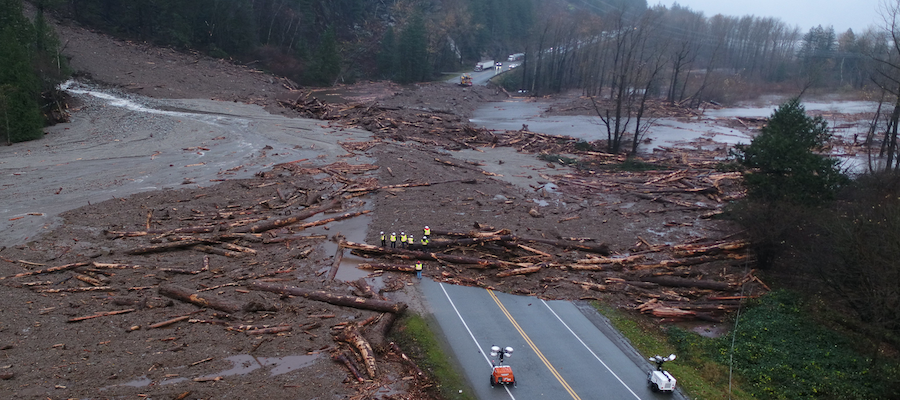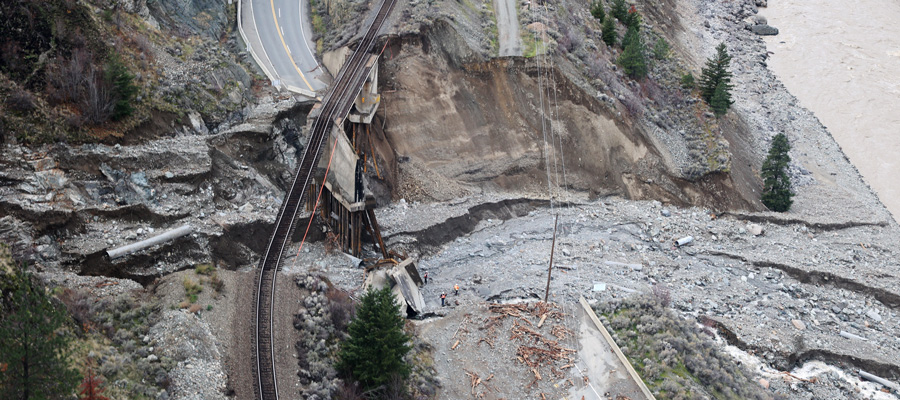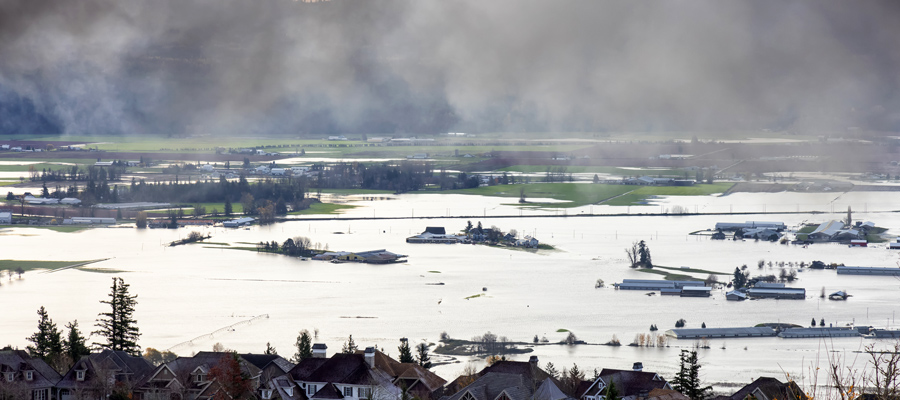Government to investigate deadly landslide

Months after five killed, experts to determine if failed logging road caused fatal mudslide
Seven months after a mudslide killed five people on Highway 99, the provincial Ministry of Forests is launching an investigation into the event, marking the first time that it has indicated that a failed logging road may be behind the tragedy.
The ministry has issued a “request for proposals” calling on engineers and geotechnical experts outside government to submit bids on a job that will assess the risks posed by old logging roads above the highway, propose fixes and delve into what exactly led to the deadly slide.
The request for proposals (RFP) notes that the area is crisscrossed by hundreds of kilometers of aging logging roads, one of which appeared to fail with devastating consequences on November 15, 2021, when motorists already trapped on the road by another landslide got hit by a thundering wall of mud, rocks and shattered trees that raced with terrifying speed down the steep mountain slope, flipping over and burying cars when it hit the highway.
The landslide occurred during the height of last November’s heavy rainstorms, which the government characterized at the time as climate change-related. But more than heavy rains appear to be behind the terrible events on Highway 99, also known as the Duffey Lake Road.
Killed in the mudslide were Brett Diederichs, Anita and Mirsad Hadzic, Kevin Heffner and Steven Taylor.
Miraculously, many others hit by the landslide managed to escape from their cars covered in the mud that had suffocated others. The survivors included Diederichs’ mother, Brenda, and his long-time partner Madison Van Rijn who had been traveling in a separate car from him when their two vehicles were forced to stop because of debris on the road.
More than heavy rains appear to be behind the terrible events on Duffey Lake Road.
The RFP comes months after news reports first appeared in the Salmon Arm Observer by reporter Martha Wickett that the landslide may have been triggered when an old logging road high up the mountain and paralleling the highway gave way.
A foreseeable and preventable tragedy
A subsequent investigation by the BC office of the Canadian Centre for Policy Alternatives and published in The Tyee detailed the concerns of a number of engineers and geoscientists with expertise on logging roads and landslides. The road engineers and slide experts urged the provincial government to take concrete actions to reduce the potential for future landslides associated with improperly deactivated logging roads.
The experts warned that unless the government got serious about addressing the threats, further tragedies were in the offing.
There are now approximately 700,000 kilometres of industrial resource roads in British Columbia, enough to circle the world 17 times. Most of those roads were built by logging companies to access timber in remote regions far from human habitation. But as the tragedy on the Duffey Lake Road indicates, some of those roads are dangerously close.
Professional engineer, Calvin VanBuskirk, called the Duffey Lake Road landslide a “foreseeable and preventable” disaster in a detailed, four-page letter that he sent to Public Safety Minister Mike Farnworth, Forests Minister Katrine Conroy and Transportation and Infrastructure Minister Rob Fleming last December, just a few weeks after the tragedy.
There are now approximately 700,000 kilometres of industrial resource roads in British Columbia, enough to circle the world 17 times.
“I would not wish this on anybody, to go through this kind of tragedy. I hope they get their act together and prevent this kind of thing from happening in the future.”
A copy of the RFP obtained by the CCPA notes that “multiple Atmospheric Rivers” occurred last November and that the heavy rains “caused damage to the provincial road network system.”
The document, which does not appear to be available on any publicly-accessible website, is making the rounds in engineering consulting firms who have until June 16 to submit their bids.
“During this event, several mudslides occurred that impacted Highway 99, one of which had fatalities associated with it,” the document notes. “The Ministry of Forests, in conjunction with the Ministry of Transportation and Infrastructure, has committed to reviewing existing road networks in the Cayoosh Creek watershed drainage area to determine associated risks with these roads and works necessary to reduce the impact of the roads.”
In his letter to the three provincial Cabinet ministers, VanBuskirk said he anticipates that BC’s Coroner’s Service and the independent forestry watchdog—the Forest Practices Board—will eventually report “on the conditions which gave rise to the landslide and subsequent fatalities.”
No time to waste
But, he warned, “the results will likely take about two years to complete. In the interim I request that the government agencies…responsible for public and highway safety, and those responsible for resource road development, form a joint interagency task force responsible for the identification, management and reduction of landslide risks.”
The RFP specifically notes that 361 kilometres of logging roads above the Duffey Lake Road are to be assessed.
“It is anticipated that some retired and non-status [logging] roads may have previously been deactivated or ‘self-deactivated’,” the document reads, adding that the successful bidder will be required to identify which of those roads may pose “moderate to high” risks and to devise plans that reduce the risks of future mudslides occurring.
There was unmistakable evidence that the event began at an old, insufficiently deactivated logging road.
He was on the ground only days after and concluded then that there was unmistakable evidence that the event began at an old, insufficiently deactivated logging road. Because the road had not been properly deactivated—a process that includes cutting cross ditches across the road surface, removing culverts and pulling back road fill among other things—unnatural water flows prevailed and weakened the ground with November’s heavy rains finally pushing things to their ultimate and fatal breaking point.
In a subsequent report he wrote detailing his trip to the landslide site, Friele wrote:
“Failures on legacy forest service roads are common enough that those of us practicing in the forest sector have been called to forensically investigate a number of them… Luckily, fatalities have been few until this recent event, which has brought the issue to the fore.”
Reached in the field recently where he was assessing slope stability hazards in the Harrison Mills area for the Fraser River Regional District, Friele said the watershed he was standing in was crisscrossed with old logging roads built in the 1960s and 1970s; roads that could be called “self deactivated.”
What that means, Friele said, is the roads were never deactivated at all and simply abandoned and allowed to deteriorate on their own. Such roads are now out there on the landscape and represent a huge and growing liability that may come back to haunt the provincial government, as now appears to be the case with the Duffey Lake Road.
In the worst cases, roads that are either not deactivated or that are improperly or insufficiently deactivated can fail, resulting in landslides, Friele says.
Steeper slopes, higher risks
The Forest Practices Board has warned the government that it has insufficient to no information at all on about 200,000 kilometres of such roads, and that those logging roads built in steep terrain are particularly dangerous and often built to poor engineering standards. If the government has not been diligent in ensuring logging companies properly deactivate those roads, ultimately they may become the government’s problem.
Given the large number of such roads and the hazards they pose, Friele says the BC government should prioritize road deactivation in regions where the risks to public health and safety are the highest, and that means watersheds like those in the Duffey Lake Road area where highways and old logging roads share the same valleys, or in valleys where logging roads are above potentially vulnerable downslope residences or communities.
Roads that are either not deactivated or that are improperly or insufficiently deactivated can fail, resulting in landslides.
First, an in-office, desk-top analysis of available maps and images to determine as much as possible what activities have occurred in the Duffey Lake area and what geotechnical risks they may pose. Second, on-the-ground fieldwork to identify where the highest risks for future mudslides may be. And third, to prepare a report that identifies where all the “moderate or high risk” geohazards are and how those risks are to be reduced.
The RFP hints at some of the problems that the Ministry anticipates lie ahead, including an acknowledgement that the area where the landslides have and may yet occur is “geotechnically complex terrain.”
“For deactivated roads, a cost/benefit analysis shall be carried out to compare the risk of reopening the road for construction access against the reduced risk provided by the proposed works,” the RFP states.
In plain English, this means that there may be cases when going in to try to reduce the risks posed by aging, insufficiently deactivated roads creates dangers of its own.
Lastly, the RFP calls for “a separate report” to be submitted to government “which determines the causes of the fatal mudslide which impacted Highway 99.”
Timing not great
VanBuskirk said that he is encouraged to see the government finally responding to the concerns that he and Friele raised months ago.
“I’m glad to see the government looking into this issue,” he said. “ But the timing is not great for the contractor as field observations are difficult in the typically drier summer conditions. It would have been way better to have had this contract in place in March or April so the office work could be done and the contractor have a chance to view the area during the freshet or snow melt.”
Going in to try to reduce the risks posed by aging, insufficiently deactivated roads may create dangers of its own.
Seven months after the deadly event, Nihad Hadzic said his family struggles constantly with their sudden loss. His father was unable to return to work after the tragedy. His mother, who suffers from Alzheimer’s, has a hard time grasping where her son is.
Now, he says, the family must live with the knowledge that a legacy of old logging roads and not just the heavy rains of last November were behind the slide that changed their lives forever.
“This could have been prevented,” Nihad says.


